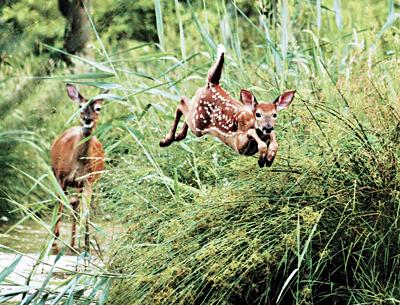Nature Notes: The Deer Didn’t Do It

The native deer population has been blamed for a lot of things, hosting ticks, causing highway accidents and vehicle damage, eating favorite ornamentals, even defecating on manicured lawns. For several years now deer have also been blamed for removing the underbrush or subshrub groundcover across the South Fork.
My own casual observations over the years gave reason to question this last accusation. Since 1980 I’ve been keeping track of the condition of the woodland vegetation, not only of the trees, but also of the stuff on the forest floor below their canopies. I have seen the groundcover eaten up firsthand, not by deer but by gypsy moth larvae and canker worms after they’ve finished stripping the trees bare. Several areas on the South Fork still bear the scars of these episodic invasions.
However, this year the insect gods have been kind, there is very little in the way of defoliation on a grand scale to observe. In fact, and perhaps owing to the generous June rains, the canopies have not looked so full and so lush in many years. Having religiously kept track of the state of the tree foliage in Southampton and East Hampton Towns since the beginning of spring, I decided to take a close look at the groundcover situation.
So, on Friday and Monday I drove the woodland roads of the two towns, east of Southampton Village and west of Napeague.
In all, I drove 32 miles of Southampton roads and 35 miles of East Hampton ones, recording the state of the undergrowth as I went. The roads covered a collective area of some 29,500 acres of prime woodlands, including East Hampton’s Northwest white pine and pitch pine forest, the morainal pitch pine and oak forests of Southampton, and those of western East Hampton, in Wainscott, for example. I also cruised the woodlands of Amagansett and Springs north of Montauk Highway.
I have the following good news regarding forest undergrowth: First of all, let me start out by saying that in my 23 years of roadside observations, I have never seen the groundcovers looking so robust, green, and thick. On my 1-to-10 lushness scale, the groundcovers along the roads I traveled consistently rated 9 and 8.5, that is equally as lush as the canopies in the trees above. Except for a few areas where American beech trees are dominant, such as along Old Stone Highway between Amagansett and Springs, where the ground was almost devoid of cover save for the leaves, the floor of every pineland and oakland forest were 30 to 100 percent covered with huckleberries and lowbush blueberries. The average coverage was about 80 percent.
Similarly, there were no signs of the viral disease that four and five years ago had wiped out many patches of them as well as mountain laurels. The leaves were almost 100 percent green. In a few spots that had been the hardest smitten by gypsy moths, such as along Hand’s Creek and Daniel’s Hole Roads and Stephen Hands Path, all in East Hampton, as much as 40 percent of the groundcover was composed of a 12-inch-high layer of Pennsylvania sedge, another native and the most common sedge species on Long Island. It had come to the ravaged woodlands’ aid after the tree, huckleberry, and blueberry leaves were eaten up by the caterpillar attack of 2000 and 2001.
As I had hypothesized, there were very few signs of deer.
What was especially pleasing to discover after two days of driving here and there in near 90-degree weather was that the “water recharge” and “aquifer protection” areas of East Hampton and Southampton, respectively, were almost completely intact. The East Hampton ones were established in 1983. Without the groundcover and the turf layer to filter and remove nitrogen products and other pollutants, the groundwater reserves sequestered in our two potable aquifers, the upper glacial and magothy, would be much less pure than they are today. The administrations in both towns in the 1980s were smart-thinking and smart-acting. Bravo East Hampton and Southampton!
At least for the moment, one of the most serious charges against deer is off the table. In all fairness to Odocoileus virginianus, shouldn’t we re-examine the others more carefully?
